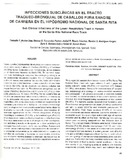Mostrar el registro sencillo del ítem
Infecciones subclínicas en el tracto traqueo-bronquial de caballos pura sangre de carrera en el hipódromo nacional de Santa Rita
| dc.rights.license | http://creativecommons.org/licenses/by-nc-sa/3.0/ve/ | |
| dc.contributor.author | Muñoz Díaz, Trohadio T. | |
| dc.contributor.author | Fernández Padrón, Marcos | |
| dc.contributor.author | Basalo S., Aníbal | |
| dc.contributor.author | Rodríguez Vargas, Mardon D. | |
| dc.contributor.author | Semeco Soto, Euro Enrique | |
| dc.contributor.author | Román Bravo, Rafael | |
| dc.date.accessioned | 2009-04-28T22:56:11Z | |
| dc.date.available | 2009-04-28T22:56:11Z | |
| dc.date.issued | 2009-04-28T22:56:11Z | |
| dc.identifier.uri | http://www.saber.ula.ve/handle/123456789/27910 | |
| dc.description.abstract | Treinta y ocho (38) muestras de equinos con edades comprendidas entre los 2 y 7 años, 21 machos (55,26%) y 17 hembras (44,74%) fueron evaluadas para hematología, todos alojados en el Hipódromo Nacional de Santa Rita. Se les tomó muestras para hematología completa, bacteriología y citología de las secreciones traqueo-bronquiales. De las muestras procesadas al menos una bacteria fue aislada, hubo aislamientos mixtos de dos o más bacterias, lo más común fue el crecimiento doble (68,42%). De las especies bacterianas aisladas con mayor frecuencia están la Pseudomonas aeruginosa con 28 casos (73,68%); Escherichia coli 13 casos (32,31 %) y Klebsiella pneumoniae 10 casos (26.32%). De los aislamientos un 64,28% se consideraron infecciones subclínicas, al detectarse en la evaluación citológica traqueo-bronquial un contaje de neutrófilos > 5% como único signo evidente de la presencia de cacterias y su efecto en el huésped. Los valores hematológicos y citológicos fueron analizados estadísticamente utilizando a prueba de suma de rangos de Wilcoxon, encontrándose diferencias significativas en los linfocitos sanguíneos (P<0,05); macrófagos alveolares (P<0,10), y hemosidorófagos (P<0,01) en el caso de animales positivos y negativos a estas bacterias. Esto deja clara evidencia de lo difícil que es emitir un diagnóstico definitivo y exacto sin la ayuda del cultivo bacteriano y la citología traqueo-bronquial en la fase subclínica. Aunado a lo anterior, es de vital importancia las condiciones de saneamiento ambiental de los establos, la calidad del aire en cuanto a la cantidad de partículas y bacterias en suspensión presentes, que de alguna manera alcanzan y colonizan las vías aéreas de estos ejemplares y que además su tracto respiratorio es sometido al estrés de entrenamiento diario favoreciendo el desarrollo de infecciones subclínicas. | es_VE |
| dc.rights | info:eu-repo/semantics/openAccess | |
| dc.subject | Equinos | es_VE |
| dc.subject | Infección | es_VE |
| dc.subject | Infección subclínica | es_VE |
| dc.subject | Infección traqueo-bronquial | es_VE |
| dc.title | Infecciones subclínicas en el tracto traqueo-bronquial de caballos pura sangre de carrera en el hipódromo nacional de Santa Rita | es_VE |
| dc.title.alternative | Sub clinical infections of the lower respiratory tract in horses at the Santa Rita national race track | es_VE |
| dc.type | info:eu-repo/semantics/article | |
| dc.description.abstract1 | Thirty eight (38) samples from horses housed at The Santa Rita National Race Track with ages between 2 and 7 years old, twenty one (21) males (55.26%) and seventeen (17) females (44.74%), were studied. Samples for complete tests of hematology, bacteriology and cytology of tracheo-bronchial secretions were processed. In all samples processed, at least one bacteria was isolated, but mixed isolations of two o more bacteria were detected, the most frequent being associations of two bacteria (68.42%). The bacteria species detected most frequently were Pseudomonas aeruginosa with 28 cases (73.68%); Escherichia coli with 13 cases (32.31%) and Klebsiella pneumoniae 10 cases (26.32%). From these isolations 64.28% of the cases were considered sub clinical infections, due to the detection of a neutrophils count 5% as a unique and evident sign of bacterial presented and its effect on the host. Hematology and cytology values were statistically analyzed with the Wilcoxon Sum of Rango Test and significant differences were found in blood lymphocytes (P<0.05); alveolar macrophages (P<0.10). and hemosiderophagy (P<0.01) in the cases of animals that were positive and negative to these bacteria. It is clearly evident how difficult it is to give a definitive diagnosis without the help of bacterial culture and cytology of tracheo-bronchial secretions at the sub clinical phase. Furthermore to these recommendations we must add the importance of healthy environmental conditions in the stables, quality of air, including quantity of partidos and bacterial suspensions present, which may reach and colonize the air ways of these horses so that their respiratory tracts are submitted to stress with daily training, favoring the development of sub clinical infections. | es_VE |
| dc.description.colacion | 83 - 95 | es_VE |
| dc.description.frecuencia | Bimestral | |
| dc.identifier.depositolegal | 0798-2259 | |
| dc.identifier.depositolegal | 199102ZU46 | |
| dc.subject.institucion | Universidad del Zulia (LUZ) | es_VE |
| dc.subject.institucion | Universidad de Los Andes (ULA) | es_VE |
| dc.subject.keywords | Equine | es_VE |
| dc.subject.keywords | Infection | es_VE |
| dc.subject.keywords | Sub-clinical infection | es_VE |
| dc.subject.keywords | Tracheobronchial infection | es_VE |
| dc.subject.publicacionelectronica | Revista Científica | |
| dc.subject.tipo | Revistas | es_VE |
| dc.type.media | Texto | es_VE |
Ficheros en el ítem
Este ítem aparece en la(s) siguiente(s) colección(ones)
-
Revista Científica - 2003 - Vol XIII - No. 002
marzo - abril



